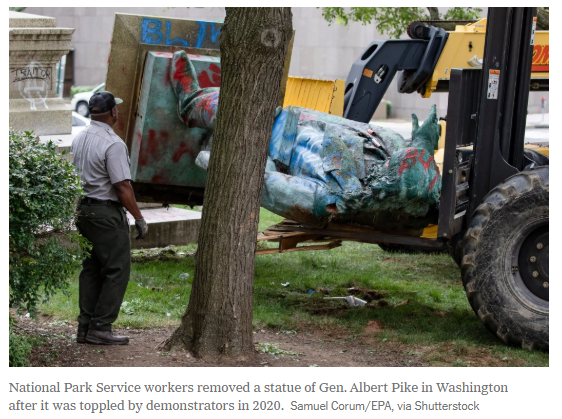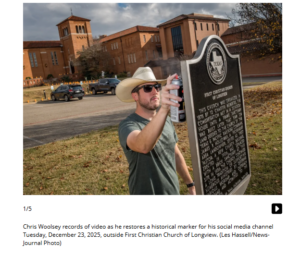Albert Pike was a Confederate general and diplomat who negotiated alliances with slave-owning Native American tribes during the Civil War.
The Trump administration will restore and reinstall the only statue that had honored a Confederate official in the U.S. capital after demonstrators toppled and set it on fire during the Black Lives Matter protests in 2020.
The defaced statue depicts Albert Pike, a Confederate diplomat and general who worked closely with Native Americans from slave-owning tribes that sided with the Confederacy during the Civil War and fought to protect slavery as an institution. He was also a prominent leader of the Freemasons — a secretive fraternal society that included many powerful politicians and elite figures in the 18th and 19th centuries.
The bronze, 11-foot-tall statue of Mr. Pike, which had been in storage since it was toppled from its perch near the Capitol grounds five years ago, was approved by Congress in 1898 and built by an order of Freemasons. The monument’s inscriptions do not directly mention Mr. Pike’s ties to the Confederacy, and the statue itself depicts him as a leader to the Freemasons. Inscriptions on the monument laud Pike as a poet, a scholar, a soldier, an orator, a jurist and a philanthropist.
The announcement by the National Park Service on Monday was the latest component of President Trump’s sweeping effort to restore Confederate symbols in the military and in public spaces. Earlier this year, Mr. Trump directed the military to restore the names of all Army bases that had been named for Confederate generals and signed an executive order calling for the restoration of public monuments that were removed during the racial justice protests that followed the murder of George Floyd by a Minneapolis police officer in 2020.
Plans to erect the statue were opposed by groups of veterans who had fought for the Union just 30 years prior. Protests and calls for the statue’s removal then swelled in the 1990s, as critics pointed to accusations that Mr. Pike had joined the Ku Klux Klan after the war — a claim others have disputed. The District of Columbia Council in Washington passed a resolution in 1992 calling for the statue to be removed and renewed the request in 2017.
Mr. Pike’s role in the Civil War centered on Native American tribes on the western frontier who were caught between the United States and the Confederacy during the Civil War. Mr. Pike was appointed as a Confederate diplomat to those tribes, and he negotiated alliances with slave-owning tribes — offering the tribes statehood and congressional representation in the Confederacy. A condition of the alliance was a declaration by the tribes that “the institution of slavery in the said nation is legal and has existed from time immemorial.”
After securing tribal support, Mr. Pike was commissioned as a brigadier general and commanded many of the Native troops who sided with the Confederacy. Native Americans fought on both sides of the conflict in the Indian Territory — now the state of Oklahoma — with some Union and Confederate contingents hailing from the same tribe.
After the war, the U.S. government negotiated new treaties with the tribes that had sided with the Confederacy, seizing tribal land and abolishing slavery. The descendants of those formerly enslaved people — known as the Freedmen — still face discrimination by the tribes and law enforcement officials.
Live footage of Mr. Pike’s statue being toppled and burned during the Black Lives Matter protests in 2020 enraged Mr. Trump, who said the act was a “disgrace to our country.” Federal police officers arrested Jason Charter, a 25-year-old Washington, D.C., resident, and charged him with destruction of federal property, accusing him of dousing the statue with lighter fluid and igniting it. That charge was later dropped, and Mr. Charter pleaded guilty in 2021 to a separate charge of attempting to topple a statue of President Andrew Jackson near the White House.
Mr. Charter said on social media on Monday that “I did not get arrested by the FBI, so that statue could go back up.”
–nytimes.com



